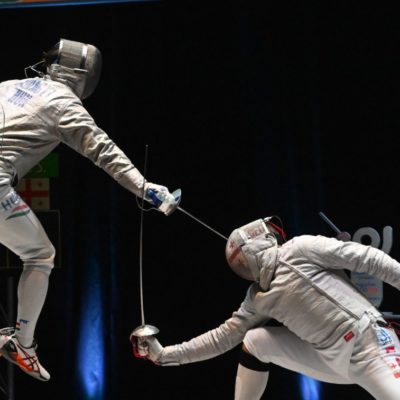Beats. How to use different types of beats for different situations.
When bouting in the fencing club, or even when executing drills, you will notice that fencers beat the blade in different ways at different times. Examining the different ways to beat the blade can help you come up with additional strategies for defeating your opponent’s use of the beat and, more importantly, to set up your own actions more effectively.
Hard vs. Soft Beats
When beating your opponent’s blade in a bout, do you always do it to parry or to immediately attack? If so, then your use of beats is one-dimensional and it is easy for an opponent to adjust to you.
When using beats, you first need to know uses for hard and soft actions. A ‘hard’ beat is what you generally use to make a parry or to make a beat-attack. A hard beating of the blade takes the point out of line long enough for you to gain priority.
Soft beats, on the other hand, are used for testing your opponent’s reactions, distance, and timing. A soft beat is like a boxer’s jab. It’s intent is to set up the opponent for the hard strike, but also serves to keep them off balance.
Using Soft Beats
How do you use soft beats to set up the attack? Try these drills:
L: Leader, P: Pupil (Lunge Distance)
1. Both enguard in 4.
P: Soft beat to L’s blade.
L: Return beat (same intensity)
P: Hard beat, lunge
L: Attempt parry
In this example, the leader responds to the pupil’s beat with the same strength. When the pupil immediately executes a much harder beat, then the leader would be taken off-guard enough for a lunge to hit.
2. Both enguard in 6.
P: Soft beat 6.
L: Return soft beat.
P: Hard change-beat 4, lunge.
L: Attempt parry
In this example, the beat 6 has the leader responding to the beat to the outside line. The pupil then makes a change-beat, resulting in a hard beat to 4 which clears out the line for the lunge.
As you get comfortable with these two drills, try them with an advance added in with the Pupil’s soft beat.
Disruption beats
Often actions to the blade have nothing to do with an immediate attack. Instead, they concentrate on disrupting the opponent’s strategy and ability to react quickly.
Try this: Get a partner and start keeping distance with each other in advance-lunge distance with your blades in a normal enguard position. Now, every time your partner starts an advance, beat their blade very hard and retreat. (You are the only one making beats.) After a few of these beats, your partner’s arm should be getting very tense and your partner will be tensing to “hold their ground” when you execute a beat.
Once you feel this, execute a feint to your partner’s inside high (4) line. The reaction should be a very wide parry 4.
Why does this happen? When having your blade beat hard a number of times, then natural reaction is to tense your weapon arm to withstand the next “attack”. By tensing your arm, you naturally lose some of your fine motor coordination and are not able to execute actions as precisely. The beats also serve to heighten your threat response, which leads to more exaggerated parries and larger blade movents. Because of this, when a perceived threat (feint or a real attack) occurs, the natural reaction is to respond with your strongest (and widest) parry.
For your bouting
When you are free fencing next, try to use beats of different intensity and see what you can set up for yourself in terms of both combination actions and predicting your partner’s reactions. If you have any questions about the topics covered here, please email me at [email protected].





